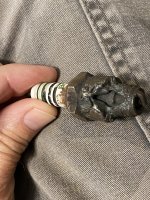If the EGT is the same why is the CHT different? (The answer of course is that the EGT temperature doesn't matter, it is just an indication of the mixture and what is happening in the cylinder. There's no point in comparing LOP EGT with ROP EGT. On a tangent... is the valve stem temperature closer to CHT or EGT?)
TEL is supposed to be changed to lead bromide not lead oxide after combustion.
The lead scavenging agent is included in the fuel, so mixture doesn't have a direct effect. What you need is temperature.
The process is roughly:
TEL -> lead oxide -> lead bromide.
The hotter the combustion the faster the reaction occurs and the more lead is converted to lead bromide and the less ends up as the undesirable intermediate products (lead oxide and lead oxy-bromides).
Also, you are trying to remove oxygen from the lead oxide, so it seems likely that excess oxygen i.e. LOP might hinder that reaction. When the heat breaks apart a lead oxide molecule, it is helpful if the oxygen is taken up by e.g. converting CO-> CO2 rather than hanging around as free oxygen that can re-combine with the lead to form lead oxide again.
If LOP is cooler and has more oxygen, the chemistry seems to say that yes, you are likely to end up with more of the undesirable lead oxide/oxy-bromides than with hotter, richer combustion.
The fact is thousands of folks fly LOP for thousands of hours with no valve sticking issues. There appears to be no correlation there. If LOP was the cause for whatever specific reason, you'd see all of these folks have sticking issues. They are not.
The OP asked about EGT effects on valve sticking. My response was EGT is the same 50 LOP and 50 ROP so
EGT alone can't be the cause- doesn't matter as you reiterated.
Since heat is sunk from the valve stem to the guide to the head and EGT is the same as we just established, guide temperature is related to CHT. What people are finding with stuck valves is coked oil. Two likely causes of that- temps too high and insufficient exchange of the oil on the stem/guide.
On some turbocharged Lycomings, they had to add pressure oiling to the guides as they had serious valve sticking and wear issues. That solved it.
There is a fine line between proper stem to guide clearance (when hot) with regards to heat transfer and having sufficient space for effective oiling between the two parts. Oil is really the heat transfer medium here as you can't have zero clearance when hot. As the coking layer thickens, clearance is reduced as is oiling. Guide temps rise leading to faster coke accumulation. Doesn't take long for that to lead to a stuck valve as the clearance reaches zero.
High CHTs should logically increase coking rate as typical exhaust stem temps in Lycomings are higher than the coking temps of most oils.
390s seem to have more problems than 320s or 360s. Not sure why that would be.
On converted liquid cooled auto engines running 100LL, we don't see valve sticking issues, despite heavy lead deposits. The heads are half the temperature of Lycomings. I'd expect combustion temps to be around the same at the same CR. We certainly see thick lead deposits in the chambers, on the valves and turbocharger turbines and housing on tear down. So lots of lead buildup everywhere but no valve sticking. Photos below at only about 100 hours to illustrate how heavily lead accumulated on my turbo parts. Exhaust valves had similar lead deposit thickness. Of course in auto engines, we also generally run synthetic oils which have higher coking temps. That could be a large mitigating factor. It certainly is in turbochargers and turbine engines.
Lead oxide is what is formed during combustion as I stated before. The lead scavenger, ethylene dibromide works to change this to lead bromide, requiring a temperature of around 250C to work and that's easily exceeded everywhere within the cylinders and exhaust areas. It's not 100% effective however so we have both lead oxide and lead bromide deposits present on exposed engine parts.
Given the look at all this, I'd go along with Larry here with surmising that low oil flow to the stems/guides may be the most probable cause for valve sticking in Lycoming engines. You want to keep stem/ guide temps below about 450F to mitigate coking.







